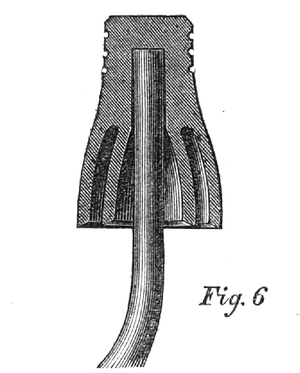[Trade Journal]
Publication: The Telegrapher
New York, NY, United States
vol. IV, no. 1, p. 1-2, col. 1-3
Telegraph Insulators at the Paris Exhibition.
IN view of the increasing interest in the important subject of insulation which has manifested itself among the members of the telegraphic profession for some time past, we have concluded to devote some space in the present number of THE TELEGRAPHER to the description and illustration of some of the leading forms of insulation used in different countries, as represented in the great exhibition at Paris. In regard to telegraphic apparatus in general there is not much on exhibition that may be called strictly new, although many modifications and improvements of well-known forms of apparatus are to be seen. The improvement most particularly noticeable is in the perfection of design and workmanship to which the makers of telegraphic apparatus have attained. Referring more especially to the subject of insulators it may be remarked that the first requisite in an insulator is, that its substance should not transmit electric currents, and that after long exposure its surface should remain in a similar condition, even when exposed to rain or the moisture deposited from damp air of a warmer temperature than the insulator itself. The second requisite is that it should possess sufficient mechanical strength to support the wire and withstand the danger of fracture or injury to which it is exposed from accidental causes, or from the mischievous attacks of stone-throwing school-boys.
In most of the European insulators exhibited, this combination of strength and insulating qualities is sought to be obtained by the use of a single-material, usually porcelain or brown earthenware. In the only American insulator on exhibition two different materials, each possessing one of the above qualities in perfection, are combined together in order to produce the same result.
We have had the fine illustrations annexed to this article engraved for the purpose of explaining more clearly than could otherwise be done, the peculiarities of some of the leading forms of insulators in the exhibition.
Figure 1 represents the English insulator known as VARLEY'S, which is extensively used in that country. This consists of two separate cups of brown earthenware cemented together with sulphur or plaster of Paris. The outer cup is provided with a groove to which the line wire is bound. The whole is dipped in and thoroughly saturated with melted paraffine, the most perfect insulating material of which we have any knowledge.
 |
| Fig 1. |
A wrought-iron bolt is cemented into the recess of the inner cup, by which the insulator is attached to the crossarm, as seen in the figure. An additional insulation is also obtained by coating the bolt or supporting pin with vulcanized rubber. The rim of the outer cap is rounded off inside, for the purpose of preventing the sprinkling of the interior with rain-water when a drop hanging upon the edge is blown off by the wind. If it happens to hand upon the windward side of the insulator, it is driven up a little distance between the two cups, but does not burst and sprinkle the interior of the cup. The great superiority of this insulator is due to its compound character. Before the current can escape it is obliged to surmount the insulation of two concentric earthenware cups, as well as the paraffine and the rubber-covered pin.
Figure 2 represents SIEMENS' and HALSKE'S celebrated insulator, which is extensively used in all parts of the Old World. It consists of a cast-iron bell with a flange attached, by which it is screwed to the post. Inside the bell is cemented a white porcelain cup, ribbed inside and out to give a good hold to the cement. Into this cup is cemented the wire hook, the stem of which is covered with vulcanized rubber. The parts are put together while hot with a cement composed of sulphur and oxide of iron.
 |
| Fig 2. |
Figure 3 is an insulator invented by Lieut. Col. CHAUVIN, Director of Prussian Telegraphs, intended for attachment to living trees when they are used as supports for telegraph lines. The insulator is hung upon a hook, free to swing, and the wire-holder is bent in a curve away from the stem of the tree, so that it cannot come in contact with it. This would be a capital arrangement for many lines in this country. Wires attached to living trees are almost invariably broken by the swaying of the trunk without some movable joint is introduced.
 |
| Fig 3. |
Figure 4 is BROOKS' American insulator, which has been fully described in a previous issue of THE TELEGRAPHER. It consists of an iron hook sulphured into a glass cup, which is again sulphured into a cylindrical iron cup, the whole being thoroughly saturated with paraffine.
 |
| Fig 4. |
Figure 5 is the insulator commonly used on the French lines. This is simply a cup of white porcelain of the shape shown in the figure cemented on to an iron bracket with sulphur. The porcelain of the insulators on exhibition is of poor quality, porous, and not very well glazed. The administration have the insulators on exhibition fixed on poles, with the wires also attached in proper form.
 |
| Fig 6. |
Figure 6 is the Prussian insulator, made of white porcelain in the form of a double bell. This insulator was originally patented by CLARK in England, and was afterwards adopted by the Prussian administration in a slightly modified form. The porcelain of which these insulators are composed is of excellent quality, of the close texture, and well glazed; there is much room, however, to doubt the perfection for any great length of time of an insulator whose non-conducting qualities depend upon a mere glazed coating which will sooner or later inevitably crack and admit moisture into its pores.
 |
| Fig 6. |
White porcelain insulators of various forms are exhibited by Russia, Switzerland, Spain, Italy and several other countries.
An English manufacturer of earthenware exhibits a great variety of different forms of insulators made of this material which seems to be a great favorite in England though little used in other countries. This material appears to be the same as that of which blacking and beer bottles are commonly made.
The two best insulators in the exhibition are unquestionably those of VARLEY and BROOKS. Their superiority over others is not only owing to the use of paraffine, but to their scientific design and construction.
Mr. BROOKS has invented an important improvement in his insulator, rendering its non-conducting qualities far superior to those of the specimen shown in the exhibition, which we shall illustrate in an early number of THE TELEGRAPHER.
